CONTROL AND COORDINATION for Class 10 BIOLOGY
INTRODUCTION
- The working together of various organs of an organism in a systematic manner so as to produce a proper response to the stimulus, is called Coordination. The control and coordination in human beings takes place through the nervous system and hormonal system which is known as the endocrine system.
- All the living organisms like plants and animals respond and react to the changes occurring around them in the environment. The changes in the environment to which organisms respond and react are called stimuli. It is a characteristic property of all living organisms.
- Both plants and animals respond to stimuli in different manners usually in the form of some movements of their body parts. For eg; If a person touches any hot object accidentally, then he/she quickly removes his/her hand away from the object in order to protect themselves. Here, the hot object acts as the stimuli and the person reacts to that stimuli by removing his/her hand away. Another example is the sunflower, as we know that sunflowers always face the sun, so here sunlight acts as a stimuli and the sunflower reacts to it by bending towards the sun.
CHAPTER WEIGHTAGE
- Generally is chapter se 2-3 questions puche jate hain. Iss chapter mein kai important topics hain like: Plant movements, Plant & Animal hormones, Reflex actions, How coordination occurs in both plants and animals.
BASIC TERMS OF THE CHAPTER
- Isse phle ki hum apna chapter shuru karein hame kuch terminologies pta honi chaea jaise:
- Affector: Wo body part jo affect ho use affector kehte hain mtlb wo nerve cell jo directly muscles ko activate kre signal send krke. Yeh neurons peripheral nervous system se CNS tak message ko leke jate hain.
- Effector: Yeh wo body part(like organ or muscle or gland or cell) hai jo ki stimuli ko respond krte hain. Mtlb yeh brain se signal leke ate hain hamare body parts tak. Jaise kisi garam object ko touch krne pe jldi se hum apna hath hta lete hai yeh hath hatane ke lia jo hamara brain message bhej rha hai wo effectors ke through hi bhejta hai.
- Receptors: Kisi bhi sense organ mein kuch cells hote hain jo kisi particular stimuli ke lia sensitive hoti hai ya keh skte hain ki unke against hi respond krte hain. Aisi cells ko receptor kehte hain. Yeh message ya information ko detect krke use impulse mein convert krte hain. Hamari body mein kafi sare receptors hain jo hmare sense organs mein present hote hain like Photoreceptors in Eyes jo hame dekhne mein help karte hain, Phonoreceptors in Ears jo sunne mein help karte hain, Gustatory receptors in tongue help in taste, Olfactory receptors in nose for smell and Thermoreceptors in skin jisse hot ya cold ka pata chalta hai.
- Neurons: Yeh hamare brain or nervous system ki fundamental unit hai. Inhi ki wajah se message receive and send kia jata hai. Sabhi neurons mein Dendrites, Cell body and Axons present hota hai. Basically 3 tarah ke neurons hote hain: Motor neurons, Sensory neurons and Interneurons.
- Endocrine glands: Yeh wo gland hai jo apna product direct blood me release karte hai and blood ke through hi wo target cells tak jata hai. Jaise ki hormones
- Exocrine glands: Yeh wo gland hai jo apna product ducts mein release karte hain. Jaise ki digestive glands and salivary glands etc.
- Hormones: Yeh hamari body ke chemical messengers hote hain jo ki blood se hoke hamari body ke target organ ya tissues pe jate hain. Inhi ki wajah se hamari body mein growth, fertility etc hota hai.
- Reflex action: Yeh wo movements hain jo ki turant or apne aap ho jate hain kisi bi stimulus ke response mein. Jaise ki hot object ko touch krne pe hum apna hand bhut jaldi remove krte hain yeh ek reflex action hai.
- Reflex arc: Reflex actions ke pathway ko reflex arc kehte hain. Isme afferent (sensory neurons) and efferent (motor neurons) hote hain.
BASIC TERMS IN THE CHAPTER
- Before we proceed we must be knowing about some terminologies like-
- Affector: It refers to the structure that affects or sends a signal. It is a nerve cell that directly activates a muscle. Affector neurons go from the peripheral nervous system to the CNS.
- Effector: It is an organ or cell of the body such as muscles or glands that acts in response to a stimulus. For eg: a muscle contracting to move an arm, a gland releasing a hormone into the blood, etc.
- Receptors: It is a cell present in the sense organs that is sensitive to a specific stimuli. It detects the information or stimuli and converts it into an impulse. These receptors are located in our sense organs. Like,
- (a) Eyes: Photoreceptors, for seeing
(b) Ears: Phonoreceptors, for hearing and maintaining balance of our body.
(c) Tongue: Gustatory receptors, for the detection of taste.
(d) Nose: Olfactory receptors, for the detection of smell.
(e) Skin: Thermoreceptors, for detection of heat or cold and sense of touch. - Neuron: The neuron is the basic working unit of the brain. It is a specialized cell which is designed to transmit information to other nerve cells, muscle, or gland cells. Most neurons have a cell body, an axon, and dendrites. There are three types of neurons:
- Sensory Neurons: These are the neurons that sense the signals and send it to the nervous system.
- Motor Neurons: These neurons transmit impulses from the spinal cord to skeletal and smooth muscles and thus control all of our muscle movements.
- Interneurons: They connect motor and sensory neurons as well as transfer signals between sensory and motor neurons.
- Exocrine glands: It is a gland that secretes its products into ducts that lead to the target tissue. For eg; sweat, salivary, sebaceous, mucous glands. The pancreas is the largest exocrine gland in our body.
- Endocrine glands: These are ductless glands that secrete their products, hormones, directly into the blood. The major glands of the endocrine system include the pineal gland, pituitary gland, pancreas, ovaries, testes, thyroid gland, parathyroid gland, hypothalamus and adrenal glands.
- Hormones: Hormones are our body's chemical messengers. They travel into the bloodstream to the tissues or organs. They affect many physiological activities including growth, metabolism, appetite, puberty and fertility.
- Reflex action: It is an involuntary and instantaneous movement in response to a stimulus. It is made possible by neural pathways called reflex arcs which act on an impulse before that impulse reaches the brain.
- Reflex arc: The anatomical pathway of a reflex is called the reflex arc. It consists of an afferent (or sensory) nerve, one or more interneurons within the central nervous system, and an efferent (motor, secretory, or secreto-motor) nerve.
CONTROL AND COORDINATION IN ANIMALS
- Ab hum padhenge ki animals mein which includes us means humans too ki hum mein kaise coordination hoti hai of various movements. Hum multicellular organisms mein specialized cells hoti hai jise Nerve cells khte hai or inhi nerve cells se milkar bnta hai nervous system.Humans mein control and coordination isi nervous system and hormonal system jise endocrine system khte hain inhi 2 systems ki wjh se hota hai. Brain, spinal cord, and nerves human nervous system ke main organs hai. Even sense organs bhi hamare nervous system ke hi part hain. Hamara nervous system information receive krta hai, fr use process krta hai yani smjhta hai, or fr use interpret krke respond krta hai.
- Fore brain: Isme cerebrum, hypothalamus and thalamus hota hai. Forebrain plays an important role in thinking, hearing, smell, sight and also in voluntary movements of our body.Isme 4 lobes bhi hoti hai: parietal lobe, temporal lobe, occipital lobe and frontal lobes.
- Midbrain: Yeh hamari body ke involuntary actions ko control krta hai or sath hi sath reflex actions ko bhi jaise blinking of eyes,etc.
- Hindbrain: It has three parts: the pons, cerebellum and medulla. Yeh help karta hai hamare posture or body balance ko maintain mein. Also it controls involuntary actions of our body.
Hamara Nervous System 2 parts mein divided hota hai, i.e Central Nervous system and Peripheral Nervous System. Central nervous system has 2 parts: Brain and spinal cord. Peripheral nervous system is further divided into the Autonomic nervous system and Voluntary nervous system.
Neurons hamare nervous system ki basic unit hai. Hamara nervous system inhi neurons se milkar bana hai. Neurons largest cell hote hai hamare body mein. Neurons 3 parts mein divided hota hai- Cell body, Dendrites and Axon. Neurons ki cell body bhi hamare baki normal cells ki tarah hi hoti hai jisme cytoplasm and nucleus hota hai. Isme nerve fibres bhi hote hai. Short nerve fibres ko dendrites khte hai or jo nerve fibres long hote hain unhe Axons khte hain. Jo bhi msg ya jo kuch bhi hame sense hota h wo receptors se hoke dendrites se pass hota hai or phir axons mein jata hai or fir next neuron ko transfer hota hai. Do neurons ke beech ke gap ko synapse kehte hain. Dkho ap agr kbhi glti se kisi hot object ko touh kr dete ho to ap ekdum se apna hath hta lete ho, ye hai reflex action. To ab dekho asal mein isme hota kya hai. Jab bhi aap kisi hot object ko touch karte ho to hamari skin mein jo receptors hote hai unhe pta chalta hai ki koi hot object touch hua hai to wha se wo msg hamare neurons se hote hue brain ya spinal cord mein jata hai. Neurons mein wo msg sbse phle dendrites mein jata hai wha se axons mein jata hai fr synapse se hote hue next neurons mein jata hai and this process goes on jb tk msg hamare spinal cord ke paas nahi pahuchta. Wha se fr hamara brain wo neurotransmitter jo ki msg ke form mein hota hai use read krta hai or hame msg send krta hai ki we have to remove our hand through motor neurons. 2 tarah ke neurons hai- sensory and motor neurons. Sensory neurons hamare organs se brain tak msg leke jate hain or motor neurons brain se msg leke aate hain hamari muscles tak ki hame apna hand remove krna hai. In this way this process is carried out. This process is reflex action and that pathway is known as reflex arc.
If we talk about the brain, Then it is divided into 3 regions: Fore brain, Midbrain and Hindbrain. Brain main coordinating centre hota hai body ka.
CONTROL AND COORDINATION IN ANIMALS
- The animals have specialised cells called nerve cells (or neurons) which respond to stimuli and coordinate the actions and activities of our body. The complex network of nerves and cells that carry messages to and from the brain and spinal cord to various organs is called Nervous system. The control and coordination in higher organisms occurs through the nervous and endocrine system.
- Cell body
- Axon
- Dendrites
- Sensory neurons: These are the neurons that sense the signals from sensory cells and send it to the central nervous system.
- Motor Neurons: These neurons transmit impulses from the spinal cord to skeletal and smooth muscles and thus control all of our muscle movements.
- Relay Neurons: It is also known as Interneurons. It serves as a link between the two neurons.
- Central Nervous System (Brain and Spinal cord)
- Peripheral Nervous System (Autonomic Nervous System and Voluntary Nervous System
- Voluntary: These actions are controlled by the Fore brain like reading, writing, eating etc.
- Involuntary: These are controlled by the Mid and Hind brain like heart beat, breathing, vomiting, etc.
- Reflex actions: These are controlled by spinal cord like removal of the hand on touching hot objects.
- Muscles are made up of muscle cells, the latter contain special proteins.
- These proteins can change their arrangement when stimulated by electrical impulses, causing the muscle cells to change shape and contract.
- When the muscle cells contract, the muscles also contract (become shorter), they pull on the bones of the body part and make it move.
- Example: Motor nerve impulse sent by the spinal cord (or brain) reaches the effector organs (arm in case of hot plate spinal reflex).
-They cause contraction of muscles in the arm, ultimately it pulls on a bone of arm and makes it move away from the hot object. - Control thoughts, sensation, action, and movements.
- Site for learning, reasoning, personality and memory.
- Coordinate all voluntary actions of the body.
- Centre associated with HUNGER.
- It consists of different areas or parts which perform different functions:
- Frontal lobe : personality, judgement, behavior, emotions, speech, writing, intelligence, concentration and self awreness.
- Parietal lobe : interprets language and words, sensation of pain, temperature or touch. Spatial and visual perception.
- Occipital lobe : interprets vision, color, light and movement.
- Temporal lobe : Understanding language, memory, hearing, sequencing and organising.
- It connects the fore-brain with the hind-brain.
- Control reflex movements of head, neck and trunk in response to visual and auditory stimuli.
- Control voluntary actions such as Change in size of the pupil, movement eye muscles and shape of the lens.
- Participate in the regulation of respiration.
- Controls posture and balance of the body.
- It helps us to make precise and accurate movements, e.g. picking a pen.
- Coordinate smooth body movements, e.g. Walking, dancing, riding, etc.
- Control involuntary actions e.g. blood pressure, heartbeat, and peristaltic movements of the alimentary canal.
- Also control reflexes such as swallowing, coughing, sneezing, secretion of saliva and vomiting.
- It begins in continuation with medulla (last part of hindbrain) and extends downwards.
- Cylindrical structure, protected inside a bony cage called the vertebral column and covered by meninges.
- There are 31 pairs of nerves which arise from the spinal cord and are concerned with spinal reflex actions and the conduction of nerve impulses to and from the brain.
- Conduct nerve impulses to and from the brain.
- Concerned with spinal reflexes.
- All the nerves of the body together make up the peripheral nervous system (PNS).
- Facilitate communication between CNS and other parts of the body.
- These nerves are of three types:-
- It is further divided into two parts:
- AUTONOMIC NERVOUS SYSTEM
- ‘Autos’ means ‘self’ and ’Nomos' means ‘governing’, that means it is a ‘Self-governing or self-operating nervous system’.
- Nerves of the autonomic nervous system are attached to the smooth muscles of the various internal organs of the human body. (e.g. head, heart, blood vessels, alimentary canal, lungs, kidneys, urinary bladder, glands and skin, etc.)
- They automatically control and regulates the activities of these organs involuntarily (without our thinking or on its own).
- Examples of processes they control: digestion, sweating, etc
- VOLUNTARY NERVOUS SYSTEM
- Actions performed by us knowingly and need thinking are referred to as voluntary actions.
- The voluntary nervous system helps us take voluntary actions that are under the conscious control of the brain. E.g. speaking to a friend, writing a letter, dancing, cycling, kicking a football, standing in a room, or sitting on a chair.
Human Nervous System
In animals control and coordination are provided by nervous and muscular tissues. The human nervous system receives information from the surroundings, processes it, interprets, and then responds accordingly.The main organs of Human Nervous Systems are: Brain, Spinal cord and Nerves. Sense organs can be considered as other organs of the nervous system as they help in the functioning of the nervous system. The Brain is located inside the skull in our head. The Spinal cord is a very thick nerve which runs in the cavity of the backbone of our body. The brain and spinal cord are connected to all the parts and sense organs of our body through the nerves. There are mainly three types of nerves present in our body: Cranial nerves, Spinal nerves and Visceral nerves. The cranial nerves connect all the parts in the head directly to the brain and spinal nerves connect other remaining parts of the body to the spinal cord.
Neuron: The Unit of nervous system
The structural and functional unit of our nervous system is called Neurons. It is the largest cell in our body. The neurons carry messages in the form of electrical signals called electrical impulses or nerve impulse over large distances in the body quickly.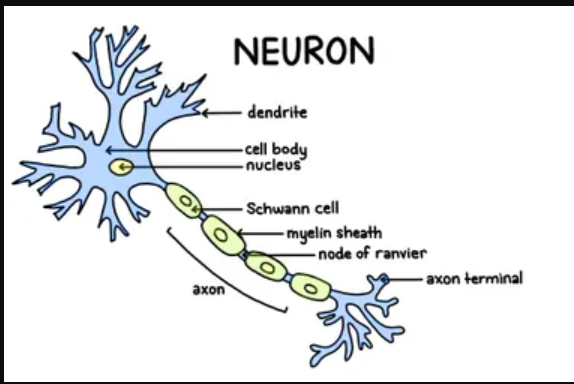
A typical neuron consists of
The cell body of a neuron is like a normal cell of our body which consists of the cytoplasm and the nucleus. The cell body acquires information which travels as an electrical impulse. A large number of long and thin fibres are coming out from the cell body of a neuron known as Nerve fibres. The shorter fibres are known as Dendrites and the longer fibres are known as Axon. The dendrites acquire information and the axon transmits electrical impulse from the cell body to the dendrite of the next neuron. The axon has a protective and insulating sheath around it which is known as Myelin sheath. It is made up of fat and proteins.
Neurons can be of three types:
A nerve impulse begins when a neuron receives a chemical stimulus. The dendrites take these impulses from the receptors and pass to the cell body and then along the axon. The message passes on to the next neuron through a junction known as Synapse. It is a very small gap between two neurons. These impulses are carried over these small gaps by means of a chemical substance known as Neurotransmitter. The cell that sends out information is called the presynaptic neuron, and the cell that receives the information is called the postsynaptic neuron.
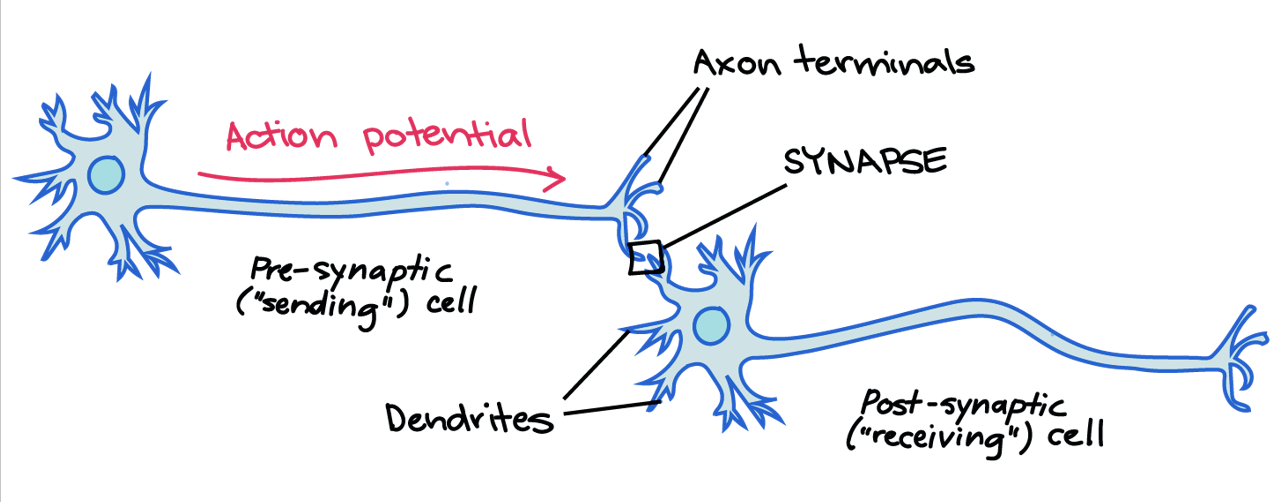
The intercellular space between the presynaptic and postsynaptic neurons is called the synaptic space or synaptic cleft. Synapses act like one way valves because the chemical substance is present on only one side of the gap. The electrical impulse or message transfers from one neuron to the other and this process goes on till the signal reaches the relay neuron in the brain and spinal cord.
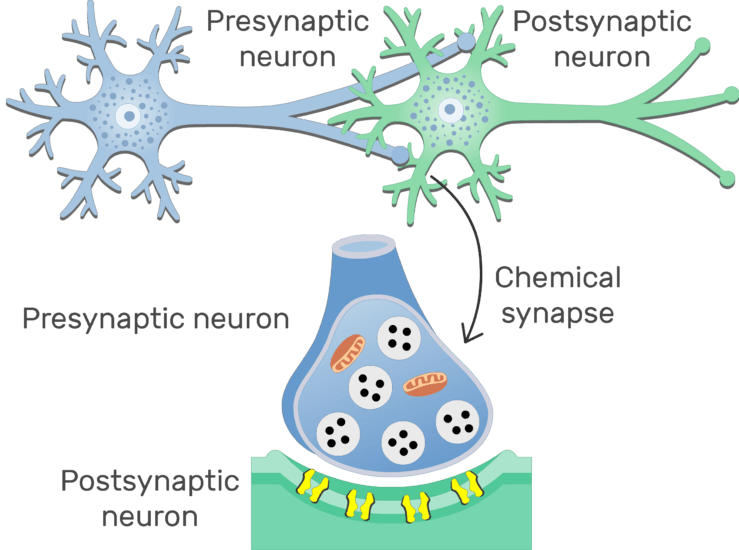
Parts of Nervous system:
The nervous system is divided into two main parts: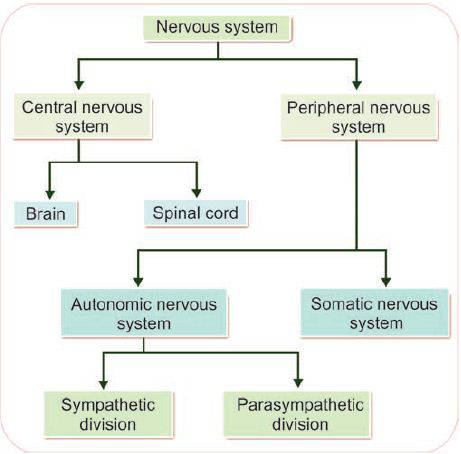
The Peripheral Nervous System:
All the nerves of the body(spinal nerves, cranial nerves and visceral nerves) together form the peripheral nervous system. There are three types of responses in the peripheral nervous system:
Reflex Action
A sudden action in response to some environment stimulus is known as reflex action. It is the simplest form of response. It occurs automatically in response to a stimulus. For example, our mouth starts watering reflexly when we are hungry or we see our favourite food, blinking our eyes, yawning, etc.The pathway of a reflex action taken by nerve impulse is known as Reflex arc.
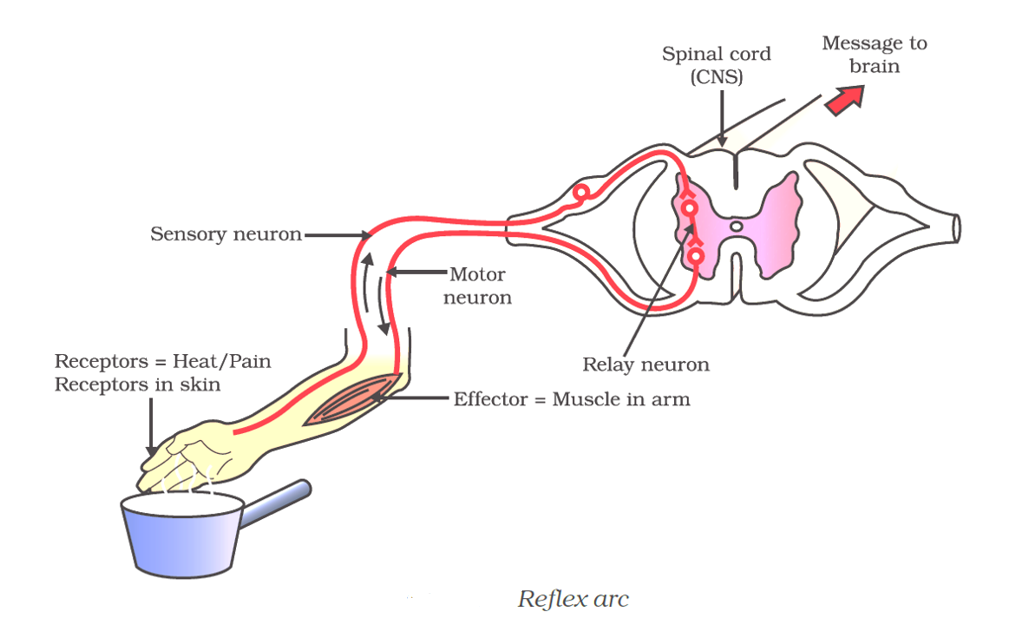
This figure shows the pathway taken by the nerve impulse in the reflex action. Here the object is hot which is felt by our receptors. The receptor triggers an impulse sensory neuron, which sends the message to the spinal cord. Now the impulse passes on to the relay neuron and then to the motor neurons. The message is then transferred to the muscles in our arm. The muscles then pull our hand away from the hot object. The muscles of the arm acts as the effector because it responds to the stimulus. This pathway is known as the reflex arc.
HOW THE EFFECTORS(MUSCLES) CAUSE ACTION OR MOVEMENT
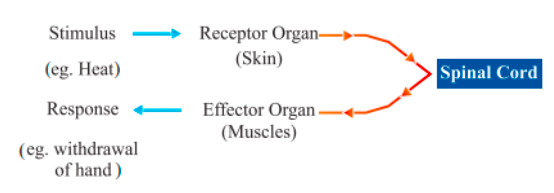
How does the Nervous system work?
The nervous system takes in information through our senses and then sends it to the brain through sense organs. The brain then processes or analyses the information and then the message is sent to the concerned muscles and triggers reactions, such as making your muscles move or causing you to feel pain. In processing of complex responses both brain and spinal cord are involved but in simple responses only the spinal cord is involved. Information is passed from one neuron to another neuron via electrical or chemical transmission.
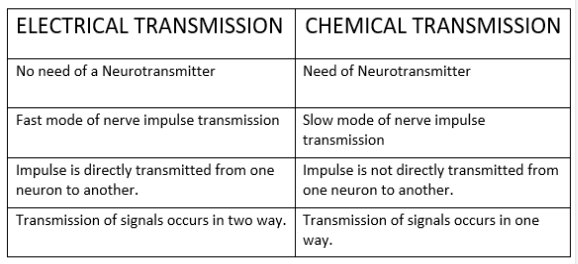
Brain:
Brain is the main coordinating centre of the body. The brain is located inside the skull of our body. It is protected by the brainy box called cranium and surrounded by the three membranes called meninges. The space between the membranes is filled with a fluid called as cerebrospinal fluid which serves many functions and also protects it from the mechanical shocks.The brain is divided into three regions: fore-brain, midbrain and hind-brain.
Fore-Brain: It consists of cerebrum, hypothalamus and thalamus. It is the main thinking part of the brain. It has different areas for hearing, sight, smell, thinking, memory,etc. It also controls voluntary movements of our body. The Centre for hunger is also located in a separate part of the forebrain. Cerebrum or the cerebral cortex consists of 4 lobes- parietal lobe, temporal lobe, occipital lobe and frontal lobes.
Midbrain: It is located between the forebrain and hindbrain. It controls certain involuntary actions in the body. It also controls the reflex movements of the eye muscles, changes in the pupil size. It also controls the reflex movements of the head, neck and the trunk.
Hind-Brain: It has three parts: the pons, cerebellum and medulla. The cerebellum controls the posture and balance of the body. It also makes precise and accurate movements. It also coordinates smooth body movements like walking, dancing, etc. The medulla controls involuntary actions like heart beat, blood pressures, etc. The Pons also controls the involuntary actions and regulates the respiration.
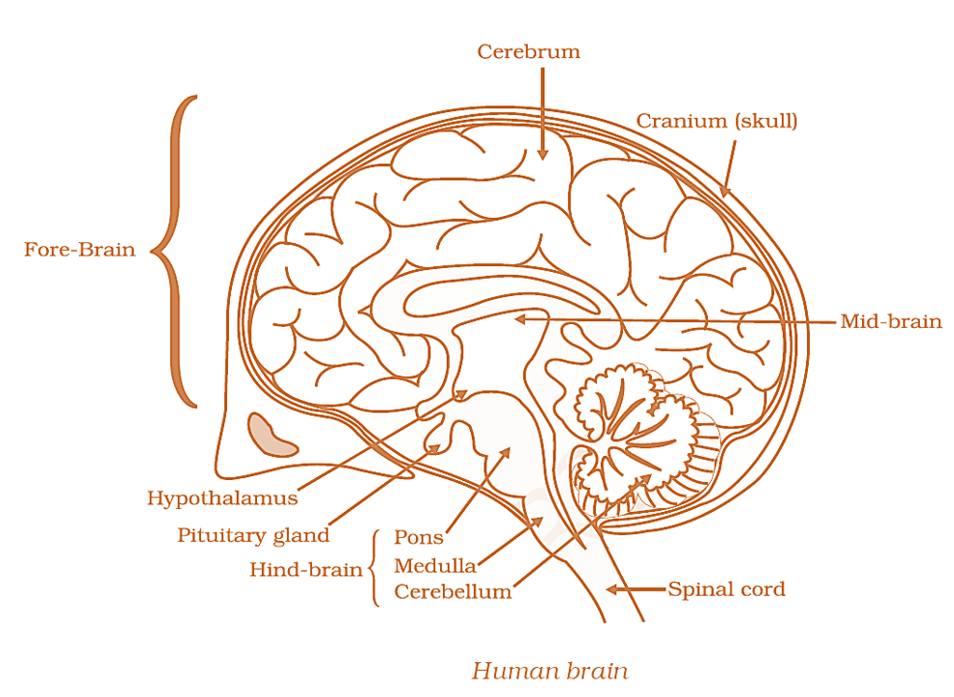
FUNCTION OF DIFFERENT PARTS OF BRAIN
FOREBRAIN
Cerebrum
MIDBRAIN
HINDBRAIN
Pons
Cerebellum
Medulla
Spinal cord:
The orangish-red part in the figure given below :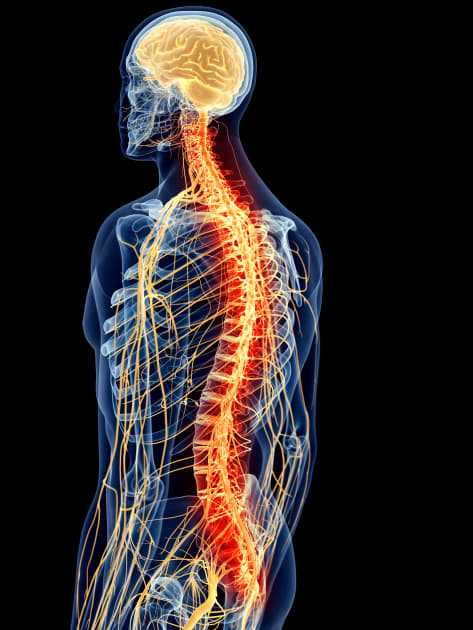
FUNCTION
PERIPHERAL NERVOUS SYSTEM
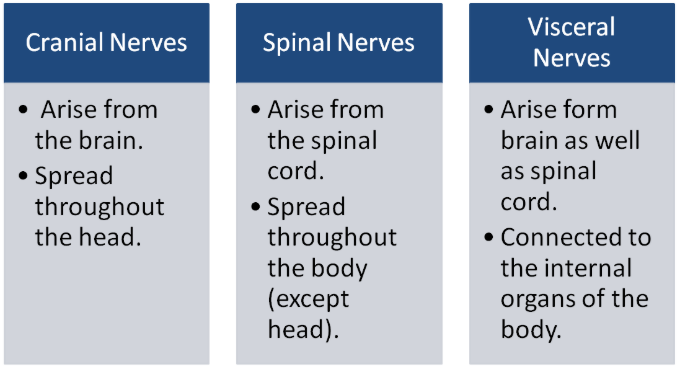
CONTROL AND COORDINATION IN PLANTS
- Plants mein nervous system or sense organs nahi hote like humans lkin wo environmental changes ko respond krte hain due to hormones jinhe Phytohormones khte hai. Majorly 4 tarah ke plant hormones hote hain like Auxins, Gibberellins, Cytokinins and Abscisic acid.
Auxins cell differentiation and cell elongation of roots and stems mein help karta hai.
Gibberellins plant ke development mein help karta hai like germination, flowering, breaking of dormancy,etc.
Cytokinins cell division ko promote krta hai or ageing in leaves ko hi delay krta hai.
Abscisic acid stomata ko close krta hai and falling and wilting yani leaves ke jhadne mein bhi help krta hai.
As you know ki plants move nai krte from one place to another to unme movements plant hormones ki wjh se hi hoti h jo ki directional movement hai. Tropism is a biological phenomenon jo indicate krta hai growth or turning movement of a plant, in response to an environmental stimulus. Agar plant ki movement towards stimulus hoti hai to use positive tropism khte hain aur agr against the stimulus hoti hai to use negative tropism khte hain.
5 tarah ke tropism hote hain: Phototropism, Geotropism, Hydrotropism, Chemotropism and Thigmotropism. Phototropism mein light stimulus hota hai, Geotropism mein gravity stimulus hota hai, chemotropism mein chemical stimulus hota hai, hydrotopism mein water stimulus hota hai or thigmotropism mein touch stimulus hota hai.
Nastic Movements or Nasties wo movement hoti hai plants ki jisme plants external stimuli ko respond to karte hain lkin direction kya hogi movement ki wo stimulus decide nahi karta mtlb ye movements non directional hoti h. Like Thigmonasty or Photonasty. Thigmonasty is the non directional movement of a plant part in response to the touch of an object and Photonasty is the non directional movement of a plant part in response to the light.
In Thigmonasty hum Mimosa pudica ka example le skte hai jisme sensitive plant bhi khte hai jise touch krne pe uski leaves fold ho jati hai. There is a reason behind this. Sensitive plant ki leaves ke base pe ek pad like structure hota hai jise pulvinus khte hain. Pulvinus ki cells mein bhut sara pani or intercellular space present hota hai. Jab bhi koi is plant ki leaves ko touch krta hai to iski leaves se water suddenly lose ho jata hai or leaves apna firmness lose kr deti hain or fold ho jati hain. Yeh sab ek electrical impulse ki wajah se hota hai jo ki touch krne pe generate hota hai aur uske bd electrical impulse plant hormones pe act krta hai aur water pulvini se intercellular spaces mein migrate krta hai. Jiski wajah se leaves lose their firmness and thus droop and fold.
In Photonasty stimuli light hota hai. For example Dandelion flower jo ki bright light ke presence mein open hota hai or evening mein close ho jata hai.
CONTROL AND COORDINATION IN PLANTS
- Plants don't have a nervous system or muscles but they still respond to the stimuli like light, gravity, water, chemicals and touch, etc. The plants coordinate to the stimuli with the help of chemical substances. Plants don’t have any nervous system so they coordinate with the help of these chemical substances only. These chemical substances in the plants are known as plant hormones or phytohormones.
- Dependent on growth
- Independent of growth.
- Auxins
- Gibberellins
- Cytokinins
- Abscisic acid(ABA)
- Phototropism- stimulus is Light
- Geotropism- stimulus is Gravity
- Chemotropism- stimulus is Chemical
- Hydrotropism- stimulus is Water
- Thigmotropism- stimulus is Touch
There are two types of movements in plants:
When we touch the Mimosa pudica, its leaves fold up but no growth occurs, so it does not involve any growth. But the movement of seedlings is due to growth. Plants convey information from cell to cell through electrical-chemical means.
Plant Hormones:
Phytohormone are signal molecules, produced within plants, that occur in extremely low concentrations. The growth of a plant can be divided into: cell division, cell enlargement and cell differentiation. The four major plant hormones are:Auxins: This promotes cell enlargement and cell differentiation in plants. It also promotes fruit growth. They are found in shoot and root tips and promote cell division, stem and root growth. This hormone is responsible for phototropic and geotropic responses of plants. Auxin moves away from light and towards gravity. It increases the growth of the stem and decreases in the roots.
Gibberellins: It regulates various developmental processes, including stem elongation, germination, helps in breaking the dormancy, flowering, flower development, and leaf and fruit senescence.
Cytokinins: It promotes cell division in plant roots and shoots. They are involved primarily in cell growth and differentiation, helps in breaking dormancy of seeds, promotes opening of stomata and buds and delay the ageing in leaves. It also promotes fruit growth.
Abscisic acid: It is synthesized within the stem, leaves, fruits, and seeds of the plant. It acts as an antagonist to Gibberellic acid therefore it inhibits the growth of plants. It is also a stress hormone because it helps by increasing the tolerance of plants to different kinds of stress. It also promotes the dormancy in seeds and buds, closing of stomata and wilting and falling of leaves.
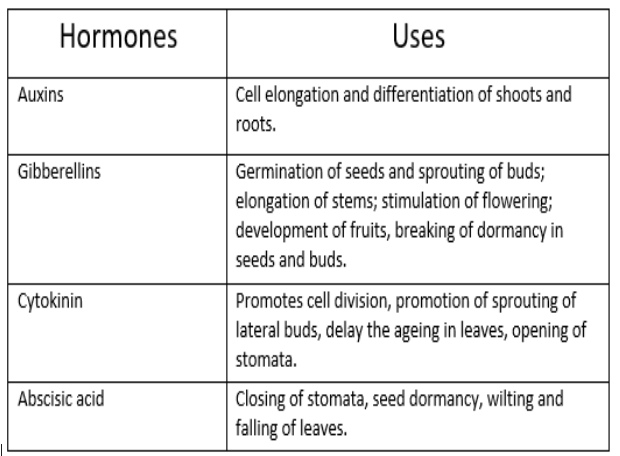
Plant Movements:
Plants don't move from one place to another. They are fixed at a place with their roots in the ground. The movements of plant parts are usually caused by an unequal growth in different parts by the action of plant hormones, under the influence of stimulus. Movement in plants can be growth independent and growth dependent.Tropism is a biological phenomenon, indicating growth or turning movement of a plant, in response to an environmental stimulus, where stimulus determines the direction of response. It is a directional movement. If the growth of the plant part is towards the stimulus, then it is called positive tropism and if the movement is away from the stimulus then it is known as negative tropism.
Types of tropism: There are five common stimuli in our environment like light, gravity, water, touch and chemicals.These five stimuli gives us five types of tropism like-
Phototropism:It is the growth or movement of plant parts in response to light. If the plant part moves towards the light then it is known as positive phototropism eg, stem and if the movement is away from the light then it is known as negative phototropism eg, roots. In this, the plant parts respond to the light and also bends towards it due to the action of auxin hormone. The auxin hormones prefer to stay in shadow and the growth occurs in that part of the plant where there is auxin.
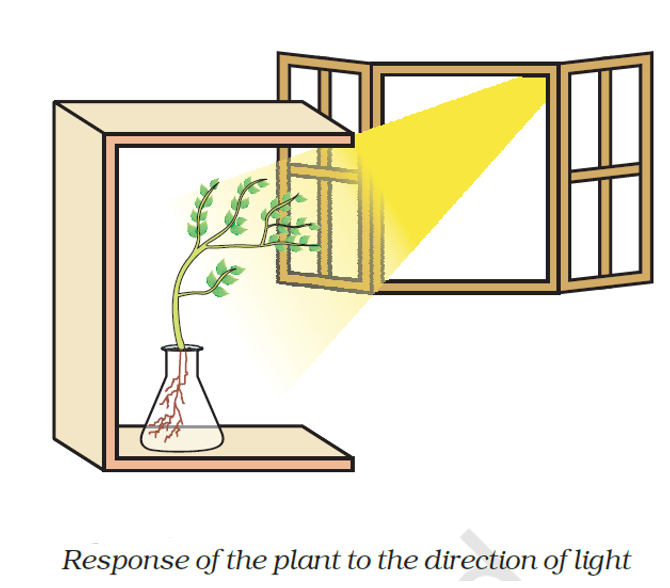
Geotropism: It is the growth or movement of plant parts in response to gravity. If the plant part moves in the direction of gravity then it is known as positive geotropism eg, roots and if the movement is against the direction of gravity then it is known as negative geotropism e.g, Stems.
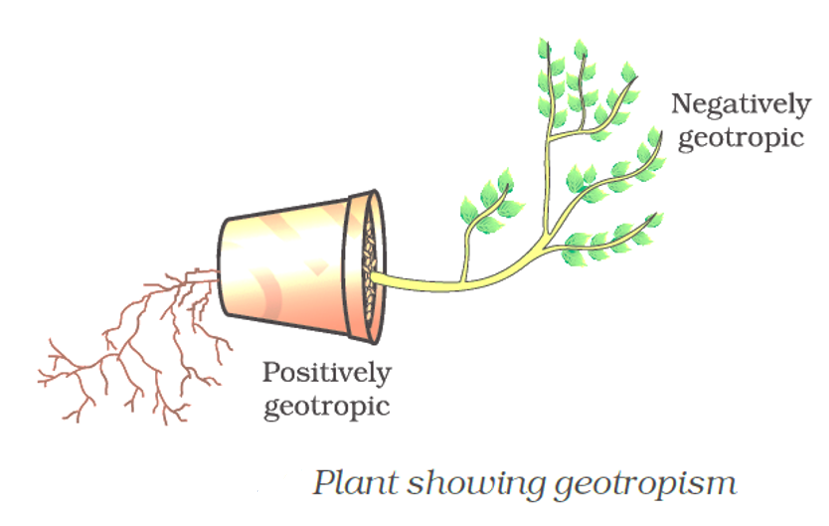
Chemotropism: It is the growth or movement of plant parts in response to chemical stimuli. If the plant part moves towards the chemical stimuli then it is known as positive chemotropism and if the movement is away from the chemical stimuli then it is known as negative chemotropism. The growth of the pollen tube towards the ovule induced by sugary substances as stimuli is an example of such tropism.
Hydrotropism: It is the growth or movement of plant parts in response to water. If the plant part moves towards water then it is known as positive phototropism eg, roots of a plant always go towards water. If the movement is away from the water then it is known as negative phototropism eg, stems.
Thigmotropism: It is the growth or movement of plant parts in response to touch of an object. If the plant part moves towards touch then it is known as positive thigmotropism. If the movement is away from the touch then it is known as negative thigmotropism. Tendrils are the thin thread like growths on the stems or leaves of the climbing plants. They are sensitive to touch. Tendrils show positive thigmotropism.

Nastic Movements or Nasties
These are the movement of plant parts in response to an external stimulus in which the direction of response is not determined by the direction of stimulus. The main difference between tropic and nastic movements is that tropic movement is a directional movement of a plant but nastic movement is not a directional movement of a plant part with respect to the stimuli. The direction of these movements is not determined by the direction of stimulus applied. In nastic movements, from whichever direction the stimulus is applied it affects all parts of the plant. For example, the folding up of the leaves of a sensitive plant on touching is not a growth movement but opening and closing of petals of flowers by the action of sunlight is a growth movement. There are many forms of nastic movements likeThigmonasty and Photonatsty.Thigmonasty: It is the non directional movement of a plant part in response to the touch of an object. We can also say that it is a touch response independent of the direction of stimulus. The leaves of Mimosa pudica have the capability to display thigmonasty (touch-induced movement). In the sensitive plant, the leaves respond to being touched, shaken, heated or rapidly cooled. The response can be seen moving down the midvein where it triggers movement of each individual leaflet. As the sensitive plant has pad-like swellings called ‘pulvini’ at the base of each leaf. The pulvini contains a lot of water in their cells and has intercellular spaces in them. The folding up of the leaves is due to the sudden loss of water from pulvini which makes it lose its firmness causing the leaves to droop and fall.
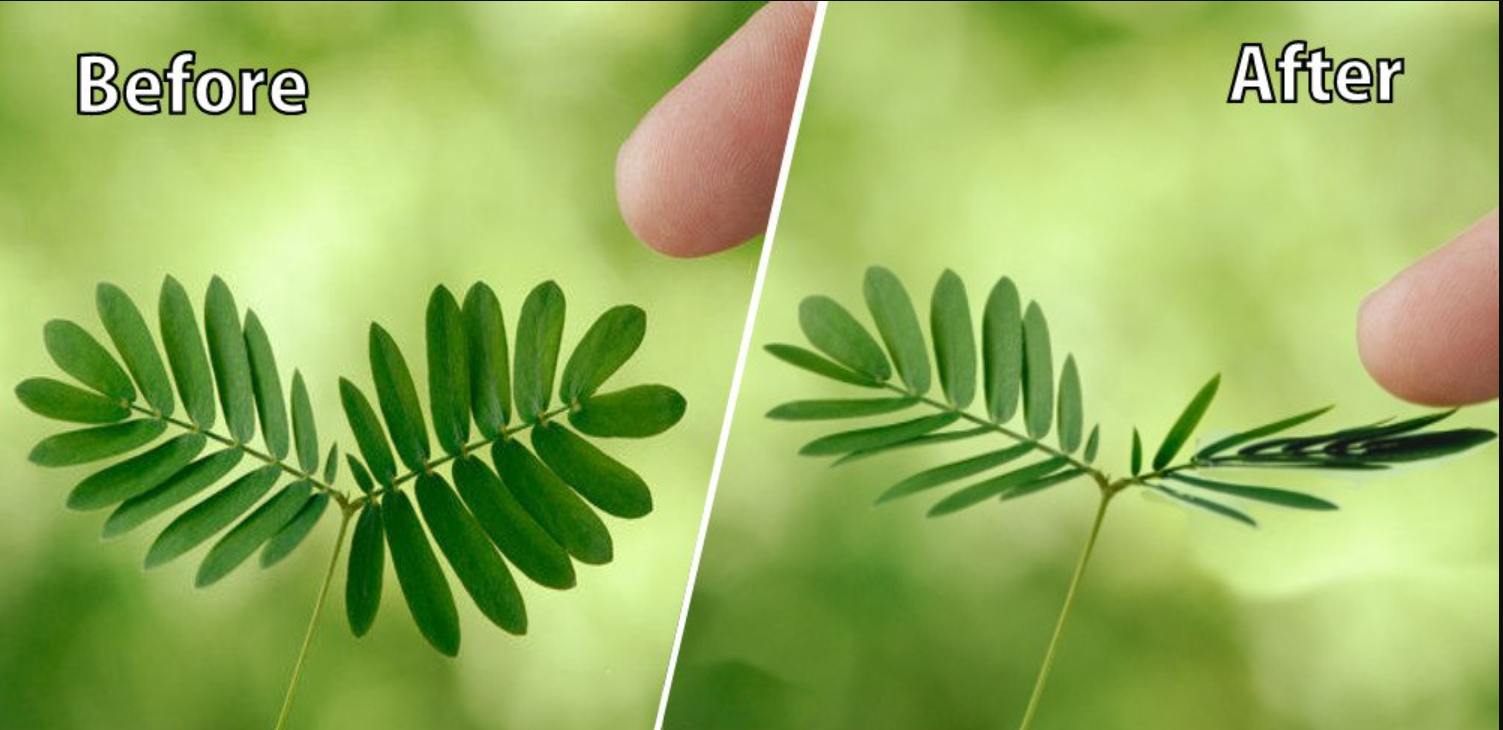
When the leaves of the sensitive plant are touched, then an electrical impulse is generated which travels through the ordinary cells . This electrical impulse acts on plant hormones and makes the water migrate from pulvini to intercellular spaces. Thus the leaves lose their firmness and thus droop and fold. After 15 to 30 min water diffuses back to the cells and leaves return to its original position.
Thigmonasty is different from thigmotropism. Both of them are a response to the touch stimulus. However, thigmotropism is a directional movement response whereas thigmonasty is not.
Photonasty: It is the non directional movement of a plant part in response to the light. For example, the Dandelion flower which opens in the morning in the presence of bright light and closes in the evening. The opening and closing of a flower in response to light are growth movements.
HORMONES IN ANIMALS
- Hormones hamari body mein chemical messengers ka kaam karte hain. Yeh hamare blood se hoke tissues ya organs tak pahuchte hai. Inhi hormones ki wajah se living organisms mein sari activities and growth regulate hoti hai.
Glands wo structure hote hain jo specific substance ko secrete karte hain hamari body mein. 2 tarah ke glands hote hain hamari body mein: Exocrine glands and Endocrine glands. Exocrine glands wo hote hain jisme ducts hoti hai mtlb jo apna product directly blood mein release nahi karte. Endocrine glands wo hote hain jisme ducts nahi hoti or ye apna product directly blood mein release karte hain. The major glands of the endocrine system include the pineal gland, pituitary gland, pancreas, ovaries, testes, thyroid gland, parathyroid gland, hypothalamus and adrenal glands.
Endocrine glands jo hormones produce krte hain wo ek messenger ka kaam krta hai hamare nervous system or organs ke beech mein. Jo complete coordination hai hamari body mein wo nervous system and endocrine system dono ki wajah se hota hai.
For example, Iodised salt hamari diet ke lia bhut important hota hai qki Iodine thyroid gland ke lia important hota hai jo ki thyroxin hormone produce krta hai. Thyroxine hormones regulate krta hai metabolism of carbohydrates, proteins and fats. Agar is hormone ki hamari body mein deficiency hoti hai to yeh Goitre cause krta hai jisme neck swell ho jati hai.
Hamari height bhi depend krta hai ki hamari body mein growth hormone kitta release hora hai. Agar yeh kam release hoga to height km hogi jisse dwarfism ho skta hai or agr yeh jada release ho gya to usse gigantism bhi ho skta hai. To islia har hormone hamari body mein proper amount mein release hona chaiye.
Another disease jise Diabetes khte hai jisme hamari body mein blood sugar level increase ho jata hai. Yeh Insulin hormone jo ki pancreas se secrete hota hai uski kami se hota hai. Isi wajah se agr kisi ka blood sugar level jada increase ho jata hai to use insulin ke injections lagae jate hai.
Isilia hamari body mein sare hormones proper amount mein release hone chaea. Agar amount kam hoga to us hormone ki deficiency ho jaegi orr agar amount jada hua to bhi wo harmful effects create krega.
HORMONES IN ANIMALS
- Hormones are the body's chemical messengers. They travel in the bloodstream to tissues or organs. They work slowly, over time, and affect many different processes, including Growth and development, Metabolism - how your body gets energy from the foods you eat, etc.
Endocrine glands are ductless glands of the endocrine system that secrete their products, hormones, directly into the blood. The major glands of the endocrine system include the pineal gland, pituitary gland, pancreas, ovaries, testes, thyroid gland, parathyroid gland, hypothalamus and adrenal glands.
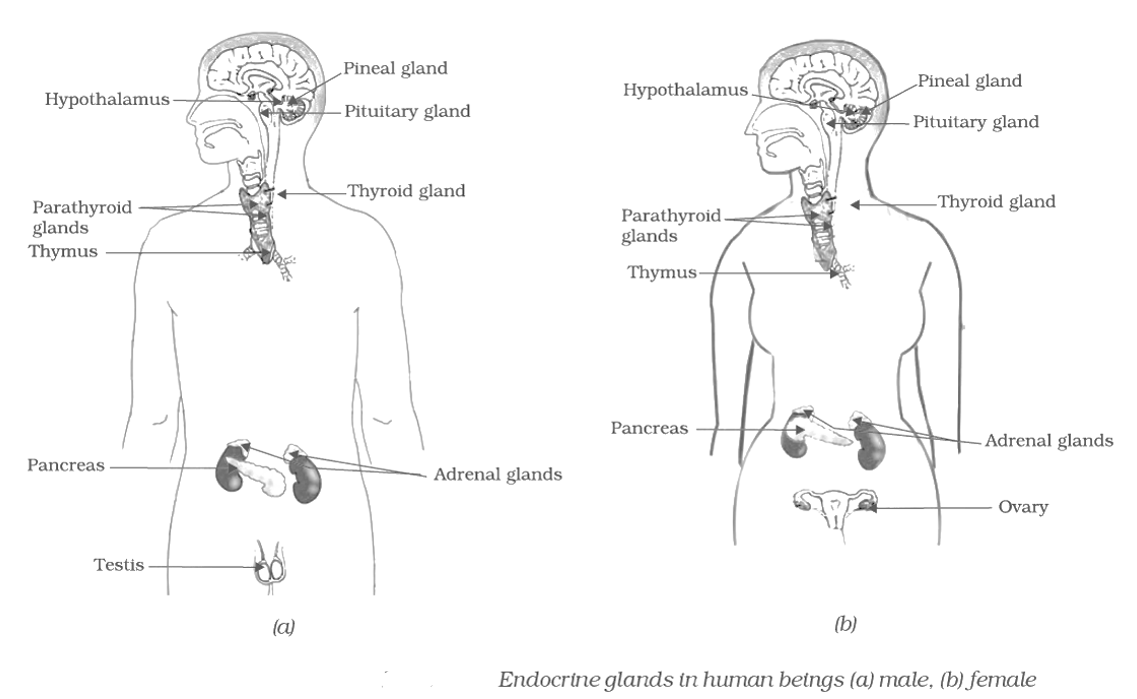
A group of endocrine glands which produce various hormones is known as Endocrine system. These hormones act as messengers between the nervous system and the organs of our body.
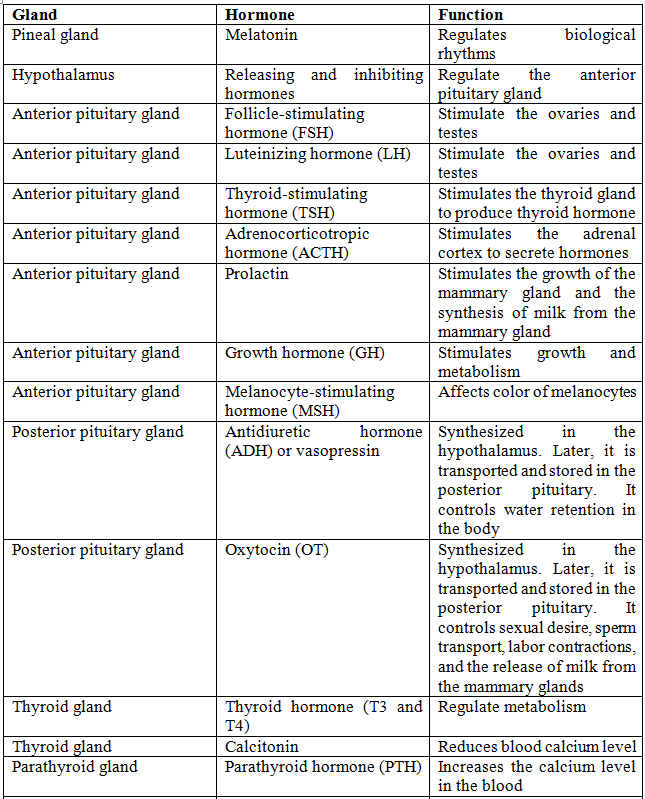
Feedback Mechanism : The excess or deficiency of hormones have harmful effects on our body. This mechanism makes sure that hormones should be secreted in precise quantities and at the right time.
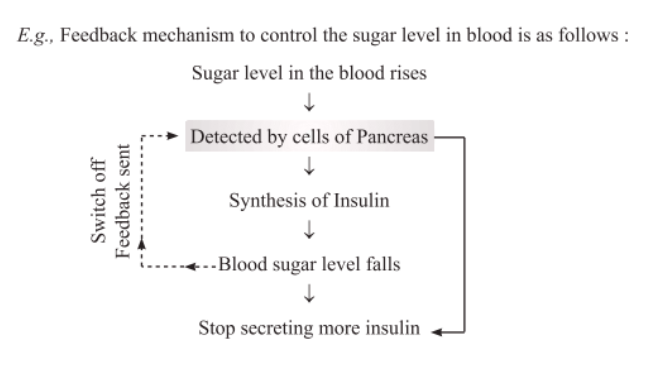
SUMMARY
- Control and coordination are the functions of the nervous system and hormones in our bodies.The responses of the nervous system can be classified as reflex action, voluntary action or involuntary action.The nervous system uses electrical impulses to transmit messages.The nervous system gets information from our sense organs and acts through our muscles. Chemical coordination is seen in both plants and animals. Hormones produced in one part of an organism move to another part to achieve the desired effect. A feedback mechanism regulates the action of hormones.